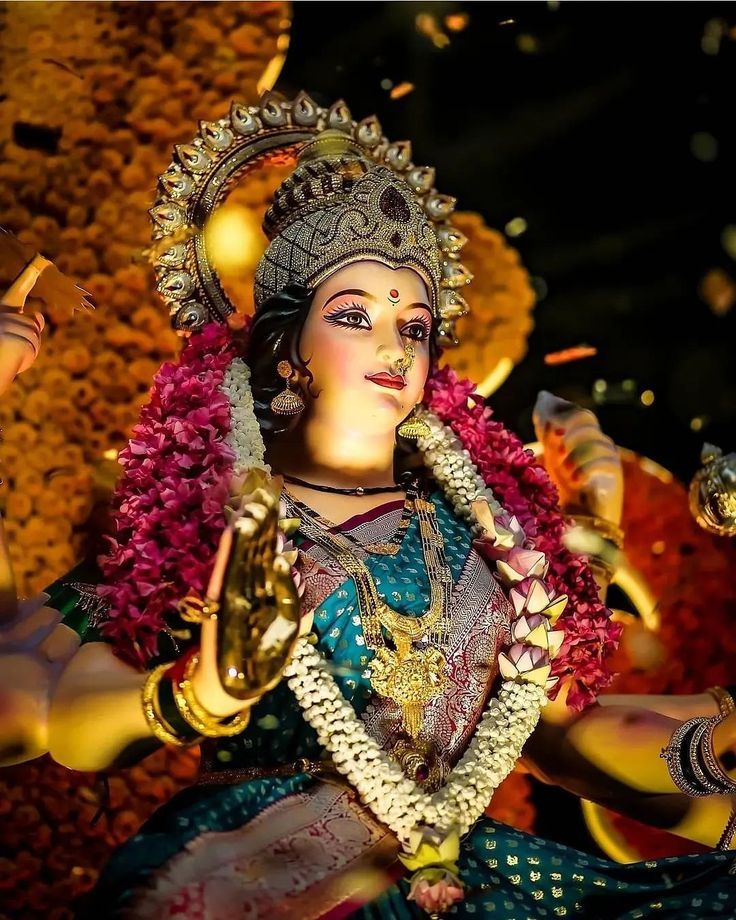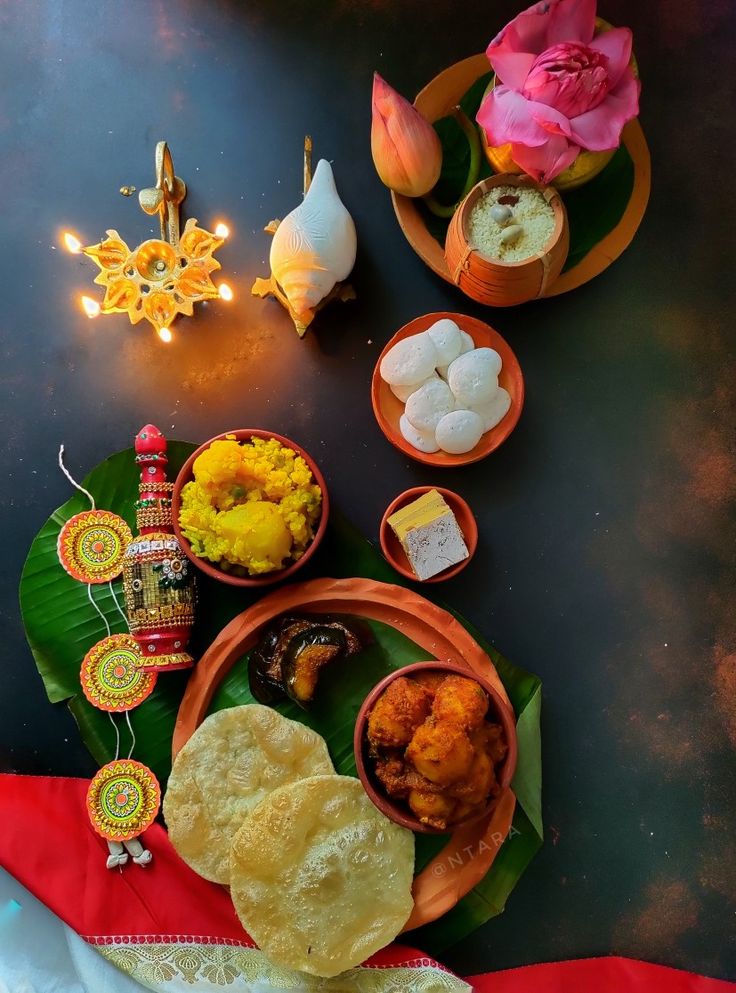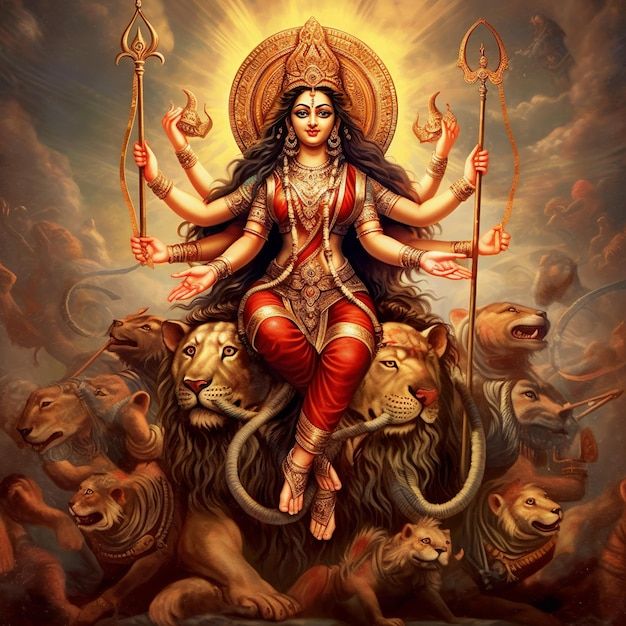
Navratri, a time of deep spiritual devotion and celebration, marks the victory of good over evil through the worship of Maa Durga and her nine distinct forms. Each day of this nine-day festival holds its own significance and is associated with a different avatar of the Goddess. To invoke the blessings of these divine forms, devotees prepare and offer various types of bhog or prasad (sacred food offerings prepared by Maa’s devotee’s) each day.
It’s Navratri time, and devotee’s are preparing for this joyous occasion. As part of a nine-day festival marking the victory of good over evil, Maa Durga or Shakti is worshipped. Additionally, people offer different bhog or prasad to the nine goddesses during these nine days. The nine forms of the Goddess are Maa Shailputri, Maa Brahmcharini, Maa Chandraghanta, Maa Kushmanda, Maa Skandmata, Maa Katyayani, Maa Kaalratri, Maa Mahagauri, and Maa Siddhidatri.
Here is a list of nine days’ worth of prasad if you wish to learn more about it.

On the initial day of Navratri, believers worship Maa Durga’s form- Maa Shailputri. They pour pure desi ghee at the feet of Goddess Shailputri. A pure ghee offering is supposed to provide individuals with a life free of sickness and ailment. Devotees offer pure desi ghee at her feet, symbolizing purity and health. It is believed that offering ghee helps ensure a life free from ailments and disease, promoting overall well-being.
Devotees venerate Maa Brahmacharini on the second day. They offer a bhog of sugar to Goddess Brahmacharini and ask for her grace and blessings. A bhog of sugar is offered to the Goddess, asking for her blessings of strength and devotion. Devotees believe this offering brings grace and peace into their lives.
Maa Chandraghanta, a fierce and powerful form of Durga, is worshiped on the third day. Devotees prepare kheer (a traditional Indian rice pudding) as an offering, symbolizing serenity and courage. Through this offering, devotees seek protection and the courage to overcome obstacles.
The devotees of Maa Durga worship Maa Kushmanda on the fourth day of Navratri. They recite shlokas and ask the Goddess for happiness, prosperity, and success. The sweetness of the offering reflects the abundance she bestows upon her followers.
The fifth day is dedicated to Maa Skandmata, the mother of Lord Kartikeya. Bananas are offered as prasad to the Goddess. This offering is symbolic of nourishment and good health, and it is believed to bless devotees with well-being and vitality.
Maa Katyayani, a warrior goddess and fierce protector, is worshipped on the sixth day of Navratri. Devotees offer honey to the Goddess, a symbol of sweetness and the preservation of purity. Honey is believed to ensure harmonious relationships and balance in life.
On the seventh day, devotees offer jaggery to Maa Kaalratri, the most fearsome form of the Goddess. Known for her power to destroy evil, the Goddess is honored with this sweet and earthy offering. Jaggery is believed to purify the body and mind, helping devotees overcome negativity and fear.
On the eighth day of Navratri, Goddess Mahagauri, is served with coconut as prasad. It is popularly believed that offering coconuts to Brahmins on Ashtami brings happiness and fortune. As Navratri approaches its final days, devotees worship Maa Mahagauri on the eighth day. Coconut is offered as prasad to honor her. The purity of the coconut symbolizes cleansing and is associated with the removal of impurities. Offering coconuts to Brahmins on this day is believed to bring happiness and good fortune.
On the final day of Navratri, Maa Siddhidatri, the granter of supernatural powers and achievements, is worshipped. Devotees offer sesame seeds (til) as bhog. This simple yet powerful offering represents humility and the desire for wisdom and enlightenment.

The tradition of offering specific prasad to different forms of Goddess during Navratri is steeped in profound spiritual significance. Each offering carries a deeper meaning beyond its physical form and has symbolic importance, rooted in ancient practices passed down through generations.
Each day of Navratri offers a unique opportunity to connect with the divine through devotion and sacred offerings. These prasad items not only honor the nine forms of Maa but also symbolize the values they represent- health, prosperity, protection, and spiritual awakening.
By following this traditional practice of offering specific bhog items, devotees seek the blessings of the Goddess for themselves and their families. Each day of Navratri becomes a stepping stone towards spiritual growth and inner peace; thus making the festival a time of personal reflection and devotion.

Navratri is more than just a religious festival- it is a time for personal reflection, spiritual growth, and community celebration. Whether you observe it through fasting, offering prasad, or attending cultural events, the essence of Navratri lies in the worship of Mata Rani and her various forms.
As you take part in the rituals and offerings this Navratri, remember that each day offers a new opportunity for devotion, self-improvement, and connection with the divine. Whether you’re following the traditional practices or incorporating modern elements, the ultimate goal is the same: to invoke the Goddess’s blessings for strength, wisdom, and prosperity.
May Maa bless you with health, happiness, and success during Navratri 2024!
If you found this article helpful or have additional insights to share, feel free to leave a comment below. We would love to hear from you!
Desi ghee is considered pure and is offered to Maa Shailputri on the first day of Navratri to promote good health and protect devotees from diseases. It symbolizes purification and vitality.
Kheer is offered as a sweet, calming dish that symbolizes serenity and peace. Devotees offer it to seek Maa Chandraghanta’s protection and courage to face challenges.
Coconut is a symbol of purity and is offered to Maa Mahagauri on the eighth day to remove impurities and obstacles in the devotee’s life. It is believed to bring happiness and good fortune.
Yes, while traditional items are often offered, you can also offer fruits, sweets, and other vegetarian items as prasad, depending on local customs and personal preference.
Jaggery and sesame seeds are considered sacred due to their purifying qualities. Jaggery helps remove negativity, while sesame seeds are associated with wisdom and humility, both of which are important during the festival.
If you liked this article or, then do write us in the comment section below.
Read More 👉 Why should garlic and onions not be consumed during Navratri?
✒️Author – Mrinalini Siingh
For Astrology, Numerology, and Reiki Services – Contact us at 9324801420 or drop your queries at [email protected]
For more information Subscribe to our website to know more about such facts.
For an enquiry, write to us at [email protected]
👉If you liked this article or, then do write us in the comment section below.
For Astrology, Numerology, and Reiki Services
We also deal in original quality and certified Rudraksha, Crystals and Gems.
👉Shop Now Original Rudraksha & Crystals
For more daily updates do like and Follow Us on our Social Channels